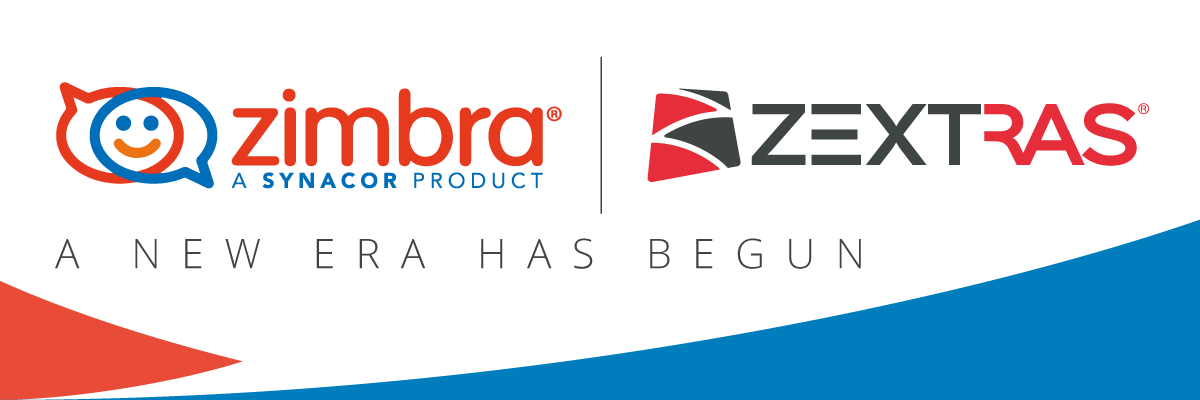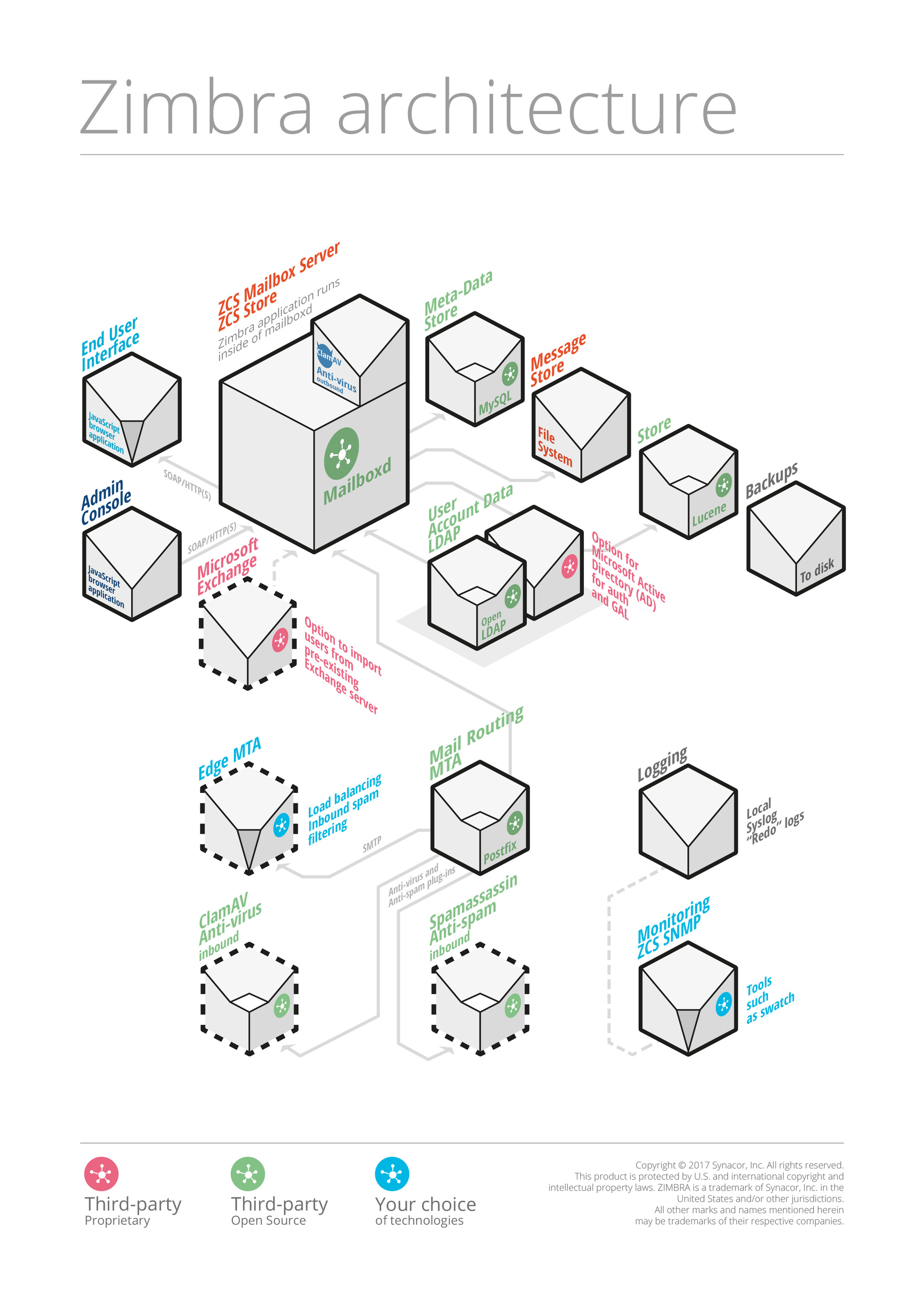What is Zimbra
Zimbra is an open source software product for automating and simplifying the joint activities of any working groups across a public or private business. Zimbra is now used in more than 5,000 companies, including such global brands as NTT Communications, Comcast, Dell, Cadbury, Investec, Rackspace, Red Hat, VMware, H & R Block and Vodafone. There are more than 100 million end users in more than 140 countries around the world. Zimbra is the third largest collaboration tool provider in the world with an active developer community and global partner network.

Zimbra consists of two platforms:
For large companies, the scalable and versatile Zimbra Collaboration Suite is the most interesting. This solution combines a corporate cloud with email capabilities and a project management system. Users share documents and folders in one product and work together in applications. chat and voice mail, Click-to-call and integration with social networks, web services and applications (Facebook, Twitter, Socialcast, Oracle and SAP).
')
Zimbra Collaboration Suite is presented in two major editions.
The Zimbra Collaboration Suite includes client and server software, as well as the following application packages.

Zimbra Core - includes libraries, utilities and basic configuration files.
Zimbra Store (Zimbra Server) - installs components for a mail server, including Jetty, which is a servlet container that runs Zimbra software within it. In the Zimbra Collaboration Suite, this servlet container is called mailboxd. The mail server includes the following components:
Zimbra LDAP - LDAP directory services provide a centralized repository for information about users and devices that are allowed to use on your network. The central repository used for Zimbra LDAP data is the OpenLDAP directory server. Zimbra Collaboration Suite uses OpenLDAP as an open source LDAP directory server. User authentication is provided through OpenLDAP. Each account on the Zimbra server has a unique mailbox identifier, which is the main point of account identification.
Note: Zimbra also supports integration with Microsoft Active Directory server.
Zimbra MTA - Postfix-open source mail transfer agent (MTA), which receives mail via SMTP protocol and delivers each message to the correct Zimbra server mailbox using local message delivery protocol (LMTP). Zimbra MTA also includes anti-virus and anti-spam components.
Zimbra-SNMP - Zimbra uses a pattern to monitor syslog output to generate SNMP traps.
Zimbra Logger - installs tools for syslog aggregation, reporting. If you do not install Logger, the statistics section of the administration console server will not be displayed.
Zimbra Spell - Aspell is an open source spelling checker used by the Zimbra web client.
Zimbra Proxy and Zimbra Memcached are zimbra proxy packages.
Zimbra System Directory Tree - the main directories created by Zimbra installation packages.
Zimbra Desktop is a client email application that can be used as an email client to any server (postfix, exchange, lotus). Zimbra Web Access provides all the same features as Zimbra Desktop, but it works through a browser.
Zimbra is a very flexible functionality for administration and deployment. The architecture of the software product includes open source development using standard protocols. Third-party software is included in Zimbra and is part of the installation process.
Minimum system requirements: Intel / AMD 2.0 GHZ + 8 GB Ram, 10 GB disk space.
With a redesigned browser-based interface, Zimbra offers the most innovative way to exchange messages, connecting end users with information and action in their personal clouds. Mail service Zimbra Collaboration Suite will allow you to completely abandon the paper documentation and permanently solve the problem of storing important documents. The service provides convenient data archiving and access control for a certain circle of employees.
Official site - zimbra.com
Zimbra is able to compete with the most popular email programs and web services, because it offers a range of solutions for business customers.

Zimbra consists of two platforms:
- Zimbra Collaboration Suite - mail server, organizer and user personalization. This is an enterprise-class solution for collaboration with e-mail, calendar and office tools.
- Zimbra Community is a corporate social network, a virtual space for sharing files and messages between employees.
Zimbra Collaboration Suite
For large companies, the scalable and versatile Zimbra Collaboration Suite is the most interesting. This solution combines a corporate cloud with email capabilities and a project management system. Users share documents and folders in one product and work together in applications. chat and voice mail, Click-to-call and integration with social networks, web services and applications (Facebook, Twitter, Socialcast, Oracle and SAP).
')
The basic features of Zimbra Collaboration Suite:
- Delivery, storage and sending e-mail.
- Mail indexing.
- Mail server logging.
- Supports IMAP, POP, CalDAV and CarDAV protocols.
- Directory Service.
- Antispam protection (Spam Assassin).
- Anti-virus protection (ClamAV).
- Synchronization with mobile platforms: Android, iOS, Windows.
Zimbra Collaboration Suite is presented in two major editions.
- Zimbra Open Source Edition is a completely free and free version of Zimbra, containing all the main features.
- Zimbra Network Edition is a paid version of Zimbra, characterized by the possibility of domain administration, the presence of a connector for Microsoft Outlook and other functions.
The Zimbra Collaboration Suite includes client and server software, as well as the following application packages.

Zimbra Core - includes libraries, utilities and basic configuration files.
Zimbra Store (Zimbra Server) - installs components for a mail server, including Jetty, which is a servlet container that runs Zimbra software within it. In the Zimbra Collaboration Suite, this servlet container is called mailboxd. The mail server includes the following components:
- Data store is a MySQL database that contains all message metadata including tags, conversations, and pointers to where messages are stored in the file system. Mail IDs are associated with OpenLDAP user accounts.
- The message store is the place where all emails are located, including message texts and any file attachments. Messages are stored in MIME format.
- Index store - index files for each mailbox. Index and search technology provided by Apache Lucene. Each message is automatically indexed, and each mailbox has an index file associated with it.
Zimbra LDAP - LDAP directory services provide a centralized repository for information about users and devices that are allowed to use on your network. The central repository used for Zimbra LDAP data is the OpenLDAP directory server. Zimbra Collaboration Suite uses OpenLDAP as an open source LDAP directory server. User authentication is provided through OpenLDAP. Each account on the Zimbra server has a unique mailbox identifier, which is the main point of account identification.
Note: Zimbra also supports integration with Microsoft Active Directory server.
Zimbra MTA - Postfix-open source mail transfer agent (MTA), which receives mail via SMTP protocol and delivers each message to the correct Zimbra server mailbox using local message delivery protocol (LMTP). Zimbra MTA also includes anti-virus and anti-spam components.
Zimbra-SNMP - Zimbra uses a pattern to monitor syslog output to generate SNMP traps.
Zimbra Logger - installs tools for syslog aggregation, reporting. If you do not install Logger, the statistics section of the administration console server will not be displayed.
Zimbra Spell - Aspell is an open source spelling checker used by the Zimbra web client.
Zimbra Proxy and Zimbra Memcached are zimbra proxy packages.
Zimbra System Directory Tree - the main directories created by Zimbra installation packages.
Zimbra Desktop is a client email application that can be used as an email client to any server (postfix, exchange, lotus). Zimbra Web Access provides all the same features as Zimbra Desktop, but it works through a browser.
Zimbra web client features:
- Create, read, reply, forward and other standard functions,
- View mail by conversation.
- Mail tagging for easy grouping of messages.
- Advanced search and save results.
- Calendar for scheduling meetings.
- Shared calendar, e-mail folders, address books and a briefcase of folders.
- Set mailbox preferences, including defining mail filtering options
- Using ZCS Documents to create, organize, and share web documents
- Use tasks to create to-do lists and manage tasks
Administering Zimbra
Zimbra is a very flexible functionality for administration and deployment. The architecture of the software product includes open source development using standard protocols. Third-party software is included in Zimbra and is part of the installation process.
Zimbra components:
- Jetty web application server.
- Postfix, an open source mail transfer agent (MTA).
- OpenLDAP, an open source LDAP implementation that provides user authentication.
- MySQL database.
- Lucene, an open-source full-featured text search engine
- Antivirus and antispam open source components:
- ClamAV, antivirus scanner that protects against malicious files
- SpamAssassin, a mail filter that attempts to identify spam
- Amavisd - new interfaces between the MTA and one or more content inspection tools
- James / Sieve filtering used to create email filters.
Zimbra administration features:
- AJAX Web Administration Console.
- Class of Service Management (CoS)
- Add accounts and domains
- Setting account limits, both individual and CoS
- Creating and editing mailing lists
- Compatible with Microsoft Exchange 2007/2010.
- Migration from Microsoft Exchange and Domino.
- Installing virtual hosts on the domain
- Server management
- View and manage system status
- Controlling use.
Deployment options for Zimbra:
- Operating systems: RHEL, CentOS, Oracle Linux and Ubuntu.
- Cloud services: Oracle Cloud, VMware vCloud, Amazon EWS.
- Virtual machines: VMWare, Xen, KVM.
Minimum system requirements: Intel / AMD 2.0 GHZ + 8 GB Ram, 10 GB disk space.
With a redesigned browser-based interface, Zimbra offers the most innovative way to exchange messages, connecting end users with information and action in their personal clouds. Mail service Zimbra Collaboration Suite will allow you to completely abandon the paper documentation and permanently solve the problem of storing important documents. The service provides convenient data archiving and access control for a certain circle of employees.
Official site - zimbra.com
Zimbra is able to compete with the most popular email programs and web services, because it offers a range of solutions for business customers.
Source: https://habr.com/ru/post/330550/
All Articles